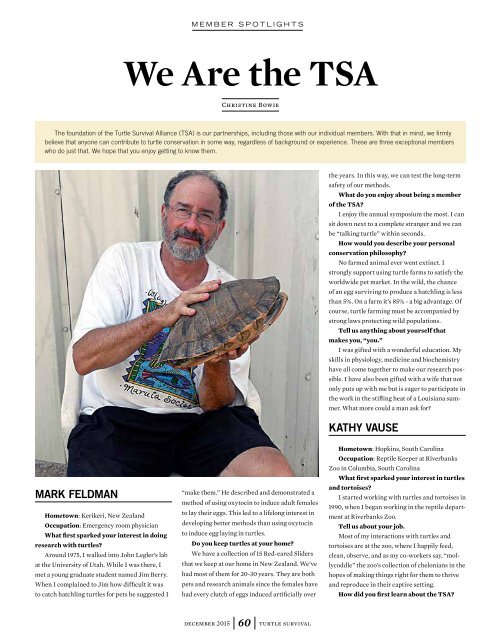Turtle Survival
2tUaeTbNi
2tUaeTbNi
You also want an ePaper? Increase the reach of your titles
YUMPU automatically turns print PDFs into web optimized ePapers that Google loves.
MEMBER SPOTLIGHTS<br />
We Are the TSA<br />
Christine Bowie<br />
The foundation of the <strong>Turtle</strong> <strong>Survival</strong> Alliance (TSA) is our partnerships, including those with our individual members. With that in mind, we firmly<br />
believe that anyone can contribute to turtle conservation in some way, regardless of background or experience. These are three exceptional members<br />
who do just that. We hope that you enjoy getting to know them.<br />
the years. In this way, we can test the long-term<br />
safety of our methods.<br />
What do you enjoy about being a member<br />
of the TSA?<br />
I enjoy the annual symposium the most. I can<br />
sit down next to a complete stranger and we can<br />
be “talking turtle” within seconds.<br />
How would you describe your personal<br />
conservation philosophy?<br />
No farmed animal ever went extinct. I<br />
strongly support using turtle farms to satisfy the<br />
worldwide pet market. In the wild, the chance<br />
of an egg surviving to produce a hatchling is less<br />
than 5%. On a farm it’s 85% - a big advantage. Of<br />
course, turtle farming must be accompanied by<br />
strong laws protecting wild populations.<br />
Tell us anything about yourself that<br />
makes you, “you.”<br />
I was gifted with a wonderful education. My<br />
skills in physiology, medicine and biochemistry<br />
have all come together to make our research possible.<br />
I have also been gifted with a wife that not<br />
only puts up with me but is eager to participate in<br />
the work in the stifling heat of a Louisiana summer.<br />
What more could a man ask for?<br />
KATHY VAUSE<br />
MARK FELDMAN<br />
Hometown: Kerikeri, New Zealand<br />
Occupation: Emergency room physician<br />
What first sparked your interest in doing<br />
research with turtles?<br />
Around 1975, I walked into John Legler’s lab<br />
at the University of Utah. While I was there, I<br />
met a young graduate student named Jim Berry.<br />
When I complained to Jim how difficult it was<br />
to catch hatchling turtles for pets he suggested I<br />
“make them.” He described and demonstrated a<br />
method of using oxytocin to induce adult females<br />
to lay their eggs. This led to a lifelong interest in<br />
developing better methods than using oxytocin<br />
to induce egg laying in turtles.<br />
Do you keep turtles at your home?<br />
We have a collection of 15 Red-eared Sliders<br />
that we keep at our home in New Zealand. We’ve<br />
had most of them for 20-30 years. They are both<br />
pets and research animals since the females have<br />
had every clutch of eggs induced artificially over<br />
Hometown: Hopkins, South Carolina<br />
Occupation: Reptile Keeper at Riverbanks<br />
Zoo in Columbia, South Carolina<br />
What first sparked your interest in turtles<br />
and tortoises?<br />
I started working with turtles and tortoises in<br />
1990, when I began working in the reptile department<br />
at Riverbanks Zoo.<br />
Tell us about your job.<br />
Most of my interactions with turtles and<br />
tortoises are at the zoo, where I happily feed,<br />
clean, observe, and as my co-workers say, “mollycoddle”<br />
the zoo’s collection of chelonians in the<br />
hopes of making things right for them to thrive<br />
and reproduce in their captive setting.<br />
How did you first learn about the TSA?<br />
december 2015 60 turtle survival


